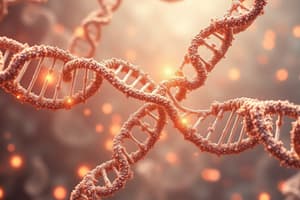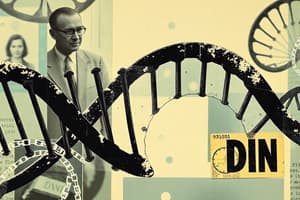Podcast
Questions and Answers
What is the role of DNA polymerase in DNA replication?
What is the role of DNA polymerase in DNA replication?
- Creates RNA primers to start replication
- Unwinds the DNA helix
- Adds complementary nucleotides to the growing strand (correct)
- Seals the gaps between Okazaki fragments
During transcription, what is the role of the promoter region?
During transcription, what is the role of the promoter region?
- It is the region where the DNA helix unwinds.
- It is the site where RNA polymerase binds to initiate transcription. (correct)
- It is the region where Okazaki fragments are joined together.
- It is the site where the mRNA is translated into protein.
What is the difference between a missense mutation and a nonsense mutation?
What is the difference between a missense mutation and a nonsense mutation?
- A missense mutation is caused by an insertion or deletion, while a nonsense mutation is caused by a substitution
- A missense mutation changes an amino acid in the protein sequence, while a nonsense mutation changes a codon to a stop codon. (correct)
- A missense mutation is a frameshift mutation, while a nonsense mutation is a point mutation.
- A missense mutation changes a codon to a stop codon, while a nonsense mutation changes a codon to a different amino acid.
What is the function of tRNA in translation?
What is the function of tRNA in translation?
Which of the following scientists is credited with discovering the double-helix structure of DNA?
Which of the following scientists is credited with discovering the double-helix structure of DNA?
What is the importance of the 5' to 3' directionality in DNA replication?
What is the importance of the 5' to 3' directionality in DNA replication?
Which of the following is NOT a type of chromosomal mutation?
Which of the following is NOT a type of chromosomal mutation?
What is the function of the lac operon in bacteria?
What is the function of the lac operon in bacteria?
Which of the following is NOT an example of an epigenetic marker?
Which of the following is NOT an example of an epigenetic marker?
What type of transcription factor represses gene expression?
What type of transcription factor represses gene expression?
What is the function of a frameshift mutation?
What is the function of a frameshift mutation?
What type of mutation results in a change in the amino acid sequence of a protein?
What type of mutation results in a change in the amino acid sequence of a protein?
Which of the following is NOT a type of RNA involved in gene expression regulation?
Which of the following is NOT a type of RNA involved in gene expression regulation?
How can mutations contribute to genetic diversity within a population?
How can mutations contribute to genetic diversity within a population?
What is the role of RNA processing in eukaryotes?
What is the role of RNA processing in eukaryotes?
What is the difference between the leading strand and the lagging strand in DNA replication?
What is the difference between the leading strand and the lagging strand in DNA replication?
What mechanism leads to deleterious changes in protein structure due to a shift in the reading frame of mRNA?
What mechanism leads to deleterious changes in protein structure due to a shift in the reading frame of mRNA?
Which enzyme is primarily responsible for creating RNA primers during DNA replication?
Which enzyme is primarily responsible for creating RNA primers during DNA replication?
In what way do positive transcription factors affect gene expression?
In what way do positive transcription factors affect gene expression?
What is the primary role of RNA polymerase during transcription?
What is the primary role of RNA polymerase during transcription?
What is a characteristic feature of chromosomal duplications?
What is a characteristic feature of chromosomal duplications?
Which codon signals the termination of translation?
Which codon signals the termination of translation?
Which of the following accurately describes a nonsense mutation?
Which of the following accurately describes a nonsense mutation?
What defines an operon in molecular biology?
What defines an operon in molecular biology?
Which type of RNA is specifically involved in regulating gene expression and preventing translation?
Which type of RNA is specifically involved in regulating gene expression and preventing translation?
What is the main function of histone modifications in gene expression?
What is the main function of histone modifications in gene expression?
What is the function of ligase during DNA replication?
What is the function of ligase during DNA replication?
In which cellular compartment does transcription occur in eukaryotes?
In which cellular compartment does transcription occur in eukaryotes?
What does DNA methylation typically do to gene expression?
What does DNA methylation typically do to gene expression?
Flashcards
Nucleotide
Nucleotide
Building block of DNA, composed of sugar, phosphate, and nitrogenous base.
Chargaff's Rule
Chargaff's Rule
A=T and C=G; rules for complementary base pairing in DNA.
Antiparallel DNA
Antiparallel DNA
Strands of DNA run in opposite directions: 5' to 3' and 3' to 5'.
DNA Replication Enzymes
DNA Replication Enzymes
Signup and view all the flashcards
Leading Strand
Leading Strand
Signup and view all the flashcards
Lagging Strand
Lagging Strand
Signup and view all the flashcards
Transcription
Transcription
Signup and view all the flashcards
Translation
Translation
Signup and view all the flashcards
Codons
Codons
Signup and view all the flashcards
Start Codon
Start Codon
Signup and view all the flashcards
Stop Codons
Stop Codons
Signup and view all the flashcards
Point Mutation
Point Mutation
Signup and view all the flashcards
Chromosomal Mutations
Chromosomal Mutations
Signup and view all the flashcards
Epigenetics
Epigenetics
Signup and view all the flashcards
Gene Expression Regulation
Gene Expression Regulation
Signup and view all the flashcards
RNA Polymerase
RNA Polymerase
Signup and view all the flashcards
RNA Processing
RNA Processing
Signup and view all the flashcards
tRNA
tRNA
Signup and view all the flashcards
Peptide Bonds
Peptide Bonds
Signup and view all the flashcards
Positive Transcription Factors
Positive Transcription Factors
Signup and view all the flashcards
Negative Transcription Factors
Negative Transcription Factors
Signup and view all the flashcards
Operon
Operon
Signup and view all the flashcards
miRNA
miRNA
Signup and view all the flashcards
Histone Modification
Histone Modification
Signup and view all the flashcards
Frameshift Mutation
Frameshift Mutation
Signup and view all the flashcards
Silent Mutation
Silent Mutation
Signup and view all the flashcards
Nonsense Mutation
Nonsense Mutation
Signup and view all the flashcards
Methylation
Methylation
Signup and view all the flashcards
Chromosomal Deletion
Chromosomal Deletion
Signup and view all the flashcards
Study Notes
DNA Structure & Replication
- Nucleotide: Composed of a sugar (deoxyribose), a phosphate group, and a nitrogenous base (A, T, C, G).
- Chargaff's Rule: A = T and C = G (complementary base pairing).
- Antiparallel: The two DNA strands run in opposite directions (5' to 3' vs 3' to 5').
- Watson and Crick: Discovered the double-helix structure.
- Rosalind Franklin: Contributed to the structure via X-ray diffraction images.
- Erwin Chargaff: Discovered base pairing rules (A = T, C = G).
- Helicase: Unwinds the DNA helix.
- DNA Polymerase: Adds complementary nucleotides to the growing strand.
- Ligase: Seals the gaps between Okazaki fragments.
- Primase: Creates RNA primers to start replication.
- Leading Strand: Synthesized continuously in the 5' to 3' direction.
- Lagging Strand: Synthesized discontinuously in fragments (Okazaki fragments).
- Okazaki Fragments: Short segments of DNA synthesized on the lagging strand.
Protein Synthesis
Transcription
- Location: Occurs in the nucleus (eukaryotes).
- Process:
- RNA Polymerase binds to DNA at the promoter region.
- RNA polymerase creates an mRNA strand using the DNA template.
- mRNA synthesis occurs from 5' to 3'.
- In eukaryotes, mRNA is processed (splicing, capping, and tailing).
Translation
- Location: Occurs in the ribosome (cytoplasm).
- Process:
- mRNA is read in sets of three bases (codons).
- tRNA brings the corresponding amino acids to the ribosome.
- Ribosome forms peptide bonds to create a polypeptide chain.
- Codon Chart/Wheel: Used to match mRNA codons to amino acids.
- START Codon: AUG, signals the beginning of translation.
- STOP Codons: UAA, UAG, UGA, signal the end of translation.
Gene Expression
- Importance: Regulates which proteins are made, when, and in what amounts.
- Transcription Factors:
- Positive: Activate/enhance gene expression.
- Negative: Repress gene expression.
- Binding Sites: Bind to specific regions on the promoter of a gene.
- Interfering RNA (RNAi):
- Types: miRNA and siRNA.
- Function: Regulate gene expression by binding to mRNA, preventing translation, or degrading mRNA.
- Operons:
- Definition: Genes regulated together.
- Example: Lac Operon (bacteria).
- Epigenetics: Study of changes in gene expression without changing DNA sequence.
- Examples: DNA Methylation (suppresses gene expression via methyl group addition to DNA) and Histone Modification (alters chromatin condensation, affecting gene accessibility).
Variation & Mutations
- Mutations: Changes in DNA sequences.
- Frameshift Mutations: Caused by insertions or deletions, shifting the reading frame of codons.
- Point Mutations: Changes in a single nucleotide.
- Substitution: One base is replaced by another.
- Silent Mutation: No change in the protein sequence.
- Missense Mutation: Changes one amino acid.
- Nonsense Mutation: Changes a codon to a stop codon, creating a truncated protein.
- Substitution: One base is replaced by another.
- Impact on Fitness: Mutations can be beneficial, harmful, or neutral for survival and reproduction.
- Chromosomal Mutations:
- Deletions: Loss of a chromosome segment.
- Duplications: Repetition of a chromosome segment.
- Inversions: Reversal of a chromosome segment.
- Translocations: Exchange of segments between non-homologous chromosomes.
- Mutations and Population Variation: Mutations contribute to genetic diversity. Natural selection can act upon these variations.
Studying That Suits You
Use AI to generate personalized quizzes and flashcards to suit your learning preferences.




